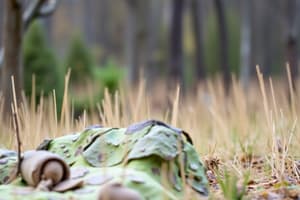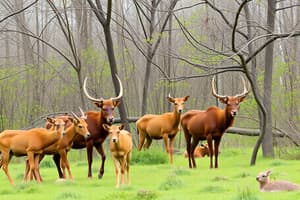Podcast
Questions and Answers
What is a population in ecology?
What is a population in ecology?
A group of interbreeding or potentially interbreeding organisms of the same species occupying a particular space at the same time.
What does demography study in population ecology?
What does demography study in population ecology?
Demography deals with the vital statistics of a population like age structure, density, birth rates, deaths, growth, and reproduction.
Which of the following characteristics are used to describe a population? (Select all that apply)
Which of the following characteristics are used to describe a population? (Select all that apply)
- Population growth (correct)
- Density (correct)
- Climate
- Age structure (correct)
What is a gene pool?
What is a gene pool?
The term used for the outgoing movement of organisms from their habitat without return is called _____
The term used for the outgoing movement of organisms from their habitat without return is called _____
What is 'dispersal' in the context of populations?
What is 'dispersal' in the context of populations?
Which type of distribution results from intraspecific competition among members of a population?
Which type of distribution results from intraspecific competition among members of a population?
Temporal dispersion refers to organisms being distributed only in space.
Temporal dispersion refers to organisms being distributed only in space.
What is the difference between immigration and emigration?
What is the difference between immigration and emigration?
What is passive dispersal?
What is passive dispersal?
Flashcards are hidden until you start studying
Study Notes
Population Definition and Characteristics
- A population is a group of organisms of the same species living in the same place at the same time, capable of interbreeding.
- Density measures the number of individuals per unit area.
- Age structure describes the proportion of individuals in different age groups.
- Population growth is determined by births, deaths, and migrations.
Population Ecology Components
- Demography studies vital statistics like age structure, density, birth rates, deaths, growth, and reproduction.
- Population genetics focuses on the breeding structure and genetic composition of a population.
- Ontogeny describes the development of an organism from its origin to maturity, considering whether it is a unitary organism or modular organism.
Individual Production
- Organisms can reproduce through unitary or modular mechanisms.
- Unitary organisms develop from a single zygote and grow into a defined adult form, like a deer.
- Modular organisms can produce new individuals (ramets) from buds or stems, like a tree.
Population Composition
- A population consists of interbreeding organisms sharing a common gene pool.
- Gene flow is the exchange of genetic information between populations.
- Populations can evolve over time through changes in gene frequency within their gene pool.
- Selective pressures from the environment can influence these changes, leading to adaptations.
- Populations can further be divided into subpopulations or 'demes' with varying population densities.
Dispersion/Distribution
- Random distribution occurs when individuals are dispersed independently of each other, common in uniform environments with no interaction among individuals.
- Uniform distribution involves evenly spaced individuals, often due to competition for resources.
- Clumped distribution is the most common, where individuals cluster together due to shared resources or social interactions.
- Temporal dispersion describes the distribution of individuals within a population over time.
- It can be influenced by daily light-dark cycles, seasonal changes, and other environmental factors.
Dispersal Movements
- Dispersal is the movement of organisms away from their birth site.
- Active dispersal occurs when organisms move under their own power.
- Passive dispersal relies on external forces like wind or water currents.
- Dispersal is vital for species survival, allowing colonization of new areas, expansion of species range, and gene flow.
- Four types of dispersal:
- Immigration is movement into a new habitat.
- Emigration is movement out of a habitat.
- Migration involves seasonal movement between habitats.
- Nigration is one-way movement without return to the original habitat.
Studying That Suits You
Use AI to generate personalized quizzes and flashcards to suit your learning preferences.




